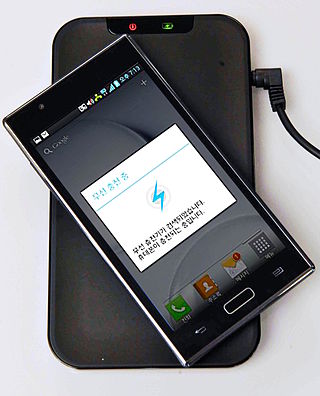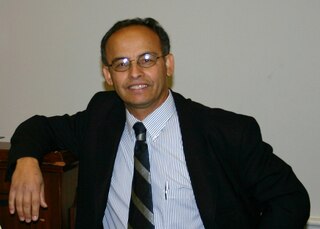Related Research Articles

Biomedical engineering (BME) or medical engineering is the application of engineering principles and design concepts to medicine and biology for healthcare applications. BME is also traditionally logical sciences to advance health care treatment, including diagnosis, monitoring, and therapy. Also included under the scope of a biomedical engineer is the management of current medical equipment in hospitals while adhering to relevant industry standards. This involves procurement, routine testing, preventive maintenance, and making equipment recommendations, a role also known as a Biomedical Equipment Technician (BMET) or as a clinical engineer.

Photonics is a branch of optics that involves the application of generation, detection, and manipulation of light in the form of photons through emission, transmission, modulation, signal processing, switching, amplification, and sensing. Photonics is closely related to quantum electronics, where quantum electronics deals with the theoretical part of it while photonics deal with its engineering applications. Though covering all light's technical applications over the whole spectrum, most photonic applications are in the range of visible and near-infrared light. The term photonics developed as an outgrowth of the first practical semiconductor light emitters invented in the early 1960s and optical fibers developed in the 1970s.

Wireless power transfer is the transmission of electrical energy without wires as a physical link. In a wireless power transmission system, an electrically powered transmitter device generates a time-varying electromagnetic field that transmits power across space to a receiver device; the receiver device extracts power from the field and supplies it to an electrical load. The technology of wireless power transmission can eliminate the use of the wires and batteries, thereby increasing the mobility, convenience, and safety of an electronic device for all users. Wireless power transfer is useful to power electrical devices where interconnecting wires are inconvenient, hazardous, or are not possible.
Federico Capasso is an Italian-American applied physicist and is one of the inventors of the quantum cascade laser during his work at Bell Laboratories. He is currently on the faculty of Harvard University.

John Roy Whinnery was an American electrical engineer and educator who worked in the fields of microwave theory and laser experimentation.
Sir Christopher Maxwell Snowden, is a British electronic engineer and academic. He was the former Vice-Chancellor of Surrey University (2005–2015), and of the University of Southampton (2015–2019). He was president of Universities UK for a two-year term until 31 July 2015. He is currently the chairman of the ERA Foundation.

Thermoacoustic imaging was originally proposed by Theodore Bowen in 1981 as a strategy for studying the absorption properties of human tissue using virtually any kind of electromagnetic radiation. But Alexander Graham Bell first reported the physical principle upon which thermoacoustic imaging is based a century earlier. He observed that audible sound could be created by illuminating an intermittent beam of sunlight onto a rubber sheet. Shortly after Bowen's work was published, other researchers proposed methodology for thermoacoustic imaging using microwaves. In 1994 researchers used an infrared laser to produce the first thermoacoustic images of near-infrared optical absorption in a tissue-mimicking phantom, albeit in two dimensions (2D). In 1995 other researchers formulated a general reconstruction algorithm by which 2D thermoacoustic images could be computed from their "projections," i.e. thermoacoustic computed tomography (TCT). By 1998 researchers at Indiana University Medical Center extended TCT to 3D and employed pulsed microwaves to produce the first fully three-dimensional (3D) thermoacoustic images of biologic tissue [an excised lamb kidney ]. The following year they created the first fully 3D thermoacoustic images of cancer in the human breast, again using pulsed microwaves. Since that time, thermoacoustic imaging has gained widespread popularity in research institutions worldwide. As of 2008, three companies were developing commercial thermoacoustic imaging systems – Seno Medical, Endra, Inc. and OptoSonics, Inc.

William B. Bridges is the Carl F Braun Professor of Engineering, Emeritus, and Professor of Electrical Engineering and Applied Physics in the Engineering and Applied Science division at the California Institute of Technology. Born in Inglewood, California, he is the discover/inventor of the Argon Ion laser, and holds the patent for the Ionized Noble Gas Laser.
The IEEE Photonics Award is a Technical Field Award established by the IEEE Board of Directors in 2002. This award is presented for outstanding achievements in photonics, including work relating to: light-generation, transmission, deflection, amplification and detection and the optical/electro-optical componentry and instrumentation used to accomplish these functions. Also included are storage technologies utilizing photonics to read or write data and optical display technologies. It also extends from energy generation/propagation, communications, information processing, storage and display, biomedical and medical uses of light and measurement applications.

Raphael Lee is an American plastic and reconstructive surgeon, biomedical engineer and inventor. He is the Paul and Allene Russell Distinguished Service Professor Emeritus at the University of Chicago and Director of Renacyte BioMolecular Technologies, Inc., a biotech investment company.
Ali Hajimiri is an academic, entrepreneur, and inventor in various fields of engineering, including electrical engineering and biomedical engineering. He is the Bren Professor of Electrical Engineering and Medical Engineering at the California Institute of Technology (Caltech).

Mounir Laroussi is a Tunisian-American scientist. He is known for his work in plasma science, especially low temperature plasmas and their biomedical applications.
Fadhel M. Ghannouchi is a Tunisian-Canadian electrical engineer, who conducts research in radio frequency (RF) technology and wireless communications.
Zorana B. (Zoya) Popović is a Yugoslav-American electrical engineer, a distinguished professor and Lockheed Martin Endowed Chair in RF Engineering in the Department of Electrical, Computer and Energy Engineering at the University of Colorado Boulder. Her research involves radio and microwave engineering, including wireless communication, millimeter wave scanners, radio frequency power transmission, and the use of rectennas to harvest radio-frequency energy.
Valencia Joyner Koomson is an associate professor in the Department of Electrical and Computer Engineering and an adjunct professor in the Department of Computer Science at the Tufts University School of Engineering. She is the principal investigator for the Advanced Integrated Circuits and Systems Lab at Tufts University.

Mohamad Sawan is a Canadian-Lebanese electrical engineer, academic and researcher. He is a Chair Professor at Westlake University, China, and an Emeritus Professor of Electrical Engineering at Polytechnique Montréal, Canada.

Igor Meglinski is a British, New Zealand and Finnish scientist serving as a principal investigator at the College of Engineering & Physical Sciences at Aston University, where he is a Professor in Quantum Biophotonics and Biomedical Engineering. He is a Faculty member in the School of Engineering and Technology at the Department of Mechanical, Biomedical & Design Engineering, and is also associated with the Aston Institute of Photonic Technologies (AIPT) and Aston Research Centre for Health in Ageing (ARCHA).
Melinda Jane Piket-May is an American engineer who is a professor of engineering at the University of Colorado Boulder. Her research investigates numerical modeling of electromagnetic phenomena and new strategies for more inclusive engineering education.
Changzhi Li is a full professor and Whitacre Endowed Chair in Electrical & Computer Engineering, at Texas Tech University. He is also head of Biomedical Integrated Devices and Systems (BIDS).
References
- ↑ "Biomed Faculty Active in Translational Research". Archived from the original on 2006-02-08.
- ↑ "Rowan names research AVP".
- ↑ "Intravascular Device and Method for Tissue Ablation for the Treatment of Pain and Cancer" (PDF). Archived from the original (PDF) on 2015-01-09. Retrieved 2015-02-11.
- ↑ Rosen, Arye; Greenspon, Arnold; Walinsky, Paul (2007). "Microwaves Treat Heart Disease". IEEE Microwave Magazine. 8: 70–75. doi:10.1109/MMW.2007.316252. S2CID 32712978.
- ↑ "For Hospitals". Archived from the original on 2015-02-12. Retrieved 2015-02-11.
- ↑ "Foundation Funds 65 Novel Ideas to Improve Global Health".
- ↑ "ROSENARYE".
- ↑ "To help poor countries, simpler health treatments not dependent on electricity". Archived from the original on January 25, 2011.
- ↑ "arye rosen".
- ↑ "RF/Microwave Interaction with Biological Tissues".
- ↑ "Guest Editorial" (PDF).